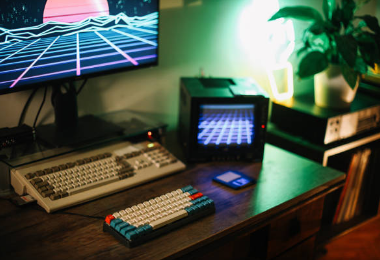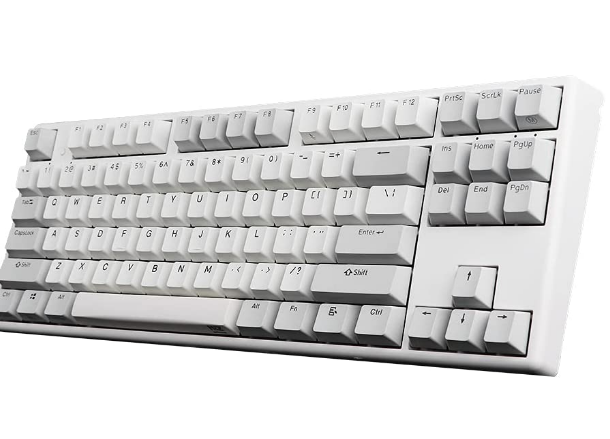Electro Capacitive Keyboard: All Facts You Should Know
An electro-capacitive keyboard measures changes on the capacitor pad or changes in electricity. This differs from contact keyboards, which use changes in electricity flows to start the register of keys when a user presses a key. Continue reading, and you will learn how an electro-capacitive keyboard works, and why choose it.
Table of Contents
What is the Electrostatic Capacitive Keyboard?
This keyboard type is fairly simple, despite its lengthy name. Electrostatic capacitive keyboards rely on capacitor pads, whereas mechanical keyboards depend on mechanical parts to deliver a keystroke. These pads disperse electrical current. When you press a key, an electrical switch is triggered rather than a physical one. As a result, they are much simpler to press down on and can register very precise motions very quickly. Because it relies less on the forceful physical touch of a user, the keyboard can also be quieter. This makes it preferable for those who value silence in their workspace.
Electrostatic capacitive keyboards, which rely on electrical impulses, react quickly to touch. Depending on the user, this may be advantageous or detrimental. Most people will find this to be a wonderful feature if they type quickly and precisely. The impulses frequently move faster than what a mechanical keyboard can typically handle. It is not really a selling point if you make mistakes frequently or don’t need it. It can, however, make a huge difference for those who value this feature.
How Electro Capacitive Keyboard Works?
Electricity always flows in capacitive keyboards, unlike traditional keyboards where it starts to flow internally when a key is pressed.
Static charges are kept in capacitors under each key. When a key is pressed, it makes contact with the capacitor pads, causing a change in capacitance at that precise location on the capacitor pad, which the keyboard recognizes and interprets as the precise keystroke.
Because a keystroke only needs to be lightly pressed to be registered, capacitive keyboards are quicker than contact keyboards.
Can I Game on Electro-capacitive Switches?
Using electro-capacitive switches for gaming is possible, but is it a good idea? Now, this is where things start to get a little trickier. First and foremost, you must be aware of what you want and—possibly more importantly—have the financial means to find it. A board with these switches will cost you a little bit more than a decent gaming keyboard, which you can currently purchase on Amazon for under $55 (opens in new tab) (£50 (opens in new tab)).
For comparison, the Niz Mini84 Pro I’ve been using costs approximately $165 (£165) from some suppliers. If you don’t know where to look, it can sometimes be difficult to find these slightly more specialized and enthusiast-level message boards. Getting one delivered was simple because The Keyboard Company carries them here in the UK. If you need something very specific, keep in mind that it might be a bit more difficult for some other boards.
Thankfully, there are a ton of manufacturers to choose from, including Niz, but Topre’s RealForce line of keyboards may be the most recognizable and well-known. Based solely on feel, these keyboards have become legendary among many enthusiasts. Jacob Ridley from PC Gamer owns one and uses it religiously. Since I’ve had the chance to use a RealForce 105UWB for a few months, I can attest that it has some of the best-feeling switches I’ve ever encountered, along with the buckling springs of the Unicomp New Model M.

How is a Capacitive Keyboard Different from a Mechanical Keyboard?
Each key on the mechanical keyboard has a complete switch underneath it. These keys may be tactile, linear, or bumpy, and pressing them causes feedback that confirms your keystroke has been received.
A capacitor membrane that, when pressed, causes an electrical reaction makes up a capacitive keyboard.
A keystroke on a mechanical keyboard is registered on the computer by the keyboard’s physical design. A capacitive keyboard, on the other hand, registers keystrokes using an electric impulse on the capacitor membrane. Instead of activating a physical switch, pressing the key moves an electric capacitor.
The Advantages of the Capacitive Keyboard
- The keyboard is easier to use and less noisy when the keys are activated in this way. It is therefore more appropriate for use in peaceful offices or locations.
- It is a fantastic option for typists or professional gamers because it registers key presses more quickly than mechanical keyboards.
- You won’t have to worry about typing because it only needs a small push to register the stroke.
The Disadvantages of the Capacitive Keyboard
- This impulse receptor might not be ideal for you if you do not require accurate typing. Due to the capacitor’s quickness in registering key presses, you might make too many mistakes.
- In comparison to a mechanical keyboard, you might feel less in control.
Conclusion on Electro Capacitive Keyboard
Your preference should be taken into account when selecting a keyboard type. While both mechanical and capacitive keyboards are easier to use and more functional than membrane keyboards, users who prefer a stress-free keyboarding experience should opt for the capacitive keyboard.
Given its lightweight and incredibly smooth keypress, an electro-capacitive keyboard is worth picking up.
Although they are somewhat pricey, if you can stretch your budget for one and find the one you like the most, you will be on to a winner.





0